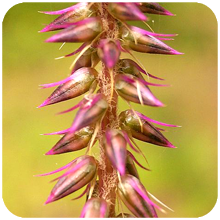 Achyranthes aspera is an erect or procumbent, annual or perennial plant, about 1-2 meters in height, often with a woody base. The stems are angular, ribbed, simple or branched from the base, having purple color. Zereth or absolute branches are rectangular, ribbed and pubescent. The leaves are thick, 3.8-6.3 x 22.5 – 4.5 cm, elliptic or obovate ovate-rounded, smooth and slightly pubescent on both sides, the margin is entire, petiolate, petiole are 6-20 mm long. Flowers are greenish white, numerous in axillary or terminal spine, seeds are subcylindrical, rounded at the base, reddish brown in color.
Achyranthes aspera is an erect or procumbent, annual or perennial plant, about 1-2 meters in height, often with a woody base. The stems are angular, ribbed, simple or branched from the base, having purple color. Zereth or absolute branches are rectangular, ribbed and pubescent. The leaves are thick, 3.8-6.3 x 22.5 – 4.5 cm, elliptic or obovate ovate-rounded, smooth and slightly pubescent on both sides, the margin is entire, petiolate, petiole are 6-20 mm long. Flowers are greenish white, numerous in axillary or terminal spine, seeds are subcylindrical, rounded at the base, reddish brown in color.
Chemical composition – Contains fatty acids, oleic acid, triterpenoid bisdesmosidic saponins, ecdysterone, n-hexachloro-14-enoic acid, oleanolic acid, triacontanol, spinasterol, dihydroxy ketones, spathulenol, alkaloids, D-glucuronic acid, betaine, achyrantin and various amino acids.
Properties – Anti-asthmatic, hepatoprotective, neuroprotective, anti-allergic, expectorant, tonic, laxative, anthelmintic, diuretic, linthontriptic, sudorific, sedative, anti-inflammatory, anticataract, antifungal, antibacterial, hypoglycemic, antihyperlipidemic and hematinic, antidepressant, anxiolytic, antinociceptive.
Recommendation – Nephrolithiasis, urolithiasis, chronic nephritis, arthralgia, menstrual disorders, infertility, cough, ascites, anasarca, costodynia, habitual abortion, leucorrhea, menoxenia, amenorrhea, dysmenorrhea, anorexia, cardiovascular problems, hemorrhoids, itching, abdominal pain, gonorrhea, lymphadenopathy neck.
This plant is incorporated in natural remedy URINOSALM.




